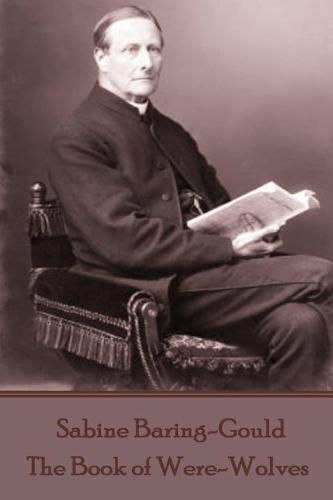Readings Newsletter
Become a Readings Member to make your shopping experience even easier.
Sign in or sign up for free!
You’re not far away from qualifying for FREE standard shipping within Australia
You’ve qualified for FREE standard shipping within Australia
The cart is loading…






Sabine Baring-Gould was born on January 28th, 1834. The family had its own manor house at Lew Trenchard on a three-thousand-acre estate, in Devon, England. His bibliography is immense. 1200 items at a minimum including the hymns ‘Onward Christian Soldiers’ and ‘Now the Day Is Over’. The family spent much of his childhood travelling in Europe and he was educated mainly by private tutors although he spent two years King’s College School in London and a few months at Warwick Grammar School. Here he contracted a bronchial disease that was to plague him throughout his life. In 1852 he gained entrance to Cambridge University, earning a Bachelor of Arts in 1857, and then a Master of Arts in 1860 from Clare College, Cambridge. As early as 1853 he had decided to become ordained. In 1864, after his education and several years teaching, he took Holy Orders. He became the curate at Horbury Bridge in West Riding. Here he met Grace Taylor, the daughter of a mill hand, aged fourteen. During the next few years they fell in love. His vicar, John Sharp, arranged for Grace to live with relatives in York to learn middle-class manners. Baring-Gould, meanwhile, relocated to become perpetual curate at Dalton, near Thirsk. He and Grace were married in 1868 at Wakefield. Their marriage lasted until her death 48 years later, and the couple had 15 children. Baring-Gould became the rector of East Mersea in Essex in 1871. In 1872 his father died and he inherited the family estates which included the gift of the living of Lew Trenchard parish. Upon its vacancy in 1881, he took the post, becoming parson as well as squire. He wrote many novels, his usual writing position was whilst standing, including The Broom-Squire set in the Devil’s Punch Bowl (1896), Mehalah and Guavas, the Tinner (1897), a collection of ghost stories, and a 16-volume The Lives of the Saints. His studies in folklore resulted in The Book of Were-Wolves (1865), a frequently cited study of lycanthropy. The popular work Curious Myths of the Middle Ages, published in two parts, in 1866 and 1868. Each of the book’s twenty-four chapters deals with one medieval superstition, its variants and history. Grace died in 1916. He had carved on her headstone: Dimidium Animae Meae ( Half my Soul ). Sabine Baring-Gould died on January 2nd, 1924 at Lew Trenchard. He was buried next to Grace.
$9.00 standard shipping within Australia
FREE standard shipping within Australia for orders over $100.00
Express & International shipping calculated at checkout
Sabine Baring-Gould was born on January 28th, 1834. The family had its own manor house at Lew Trenchard on a three-thousand-acre estate, in Devon, England. His bibliography is immense. 1200 items at a minimum including the hymns ‘Onward Christian Soldiers’ and ‘Now the Day Is Over’. The family spent much of his childhood travelling in Europe and he was educated mainly by private tutors although he spent two years King’s College School in London and a few months at Warwick Grammar School. Here he contracted a bronchial disease that was to plague him throughout his life. In 1852 he gained entrance to Cambridge University, earning a Bachelor of Arts in 1857, and then a Master of Arts in 1860 from Clare College, Cambridge. As early as 1853 he had decided to become ordained. In 1864, after his education and several years teaching, he took Holy Orders. He became the curate at Horbury Bridge in West Riding. Here he met Grace Taylor, the daughter of a mill hand, aged fourteen. During the next few years they fell in love. His vicar, John Sharp, arranged for Grace to live with relatives in York to learn middle-class manners. Baring-Gould, meanwhile, relocated to become perpetual curate at Dalton, near Thirsk. He and Grace were married in 1868 at Wakefield. Their marriage lasted until her death 48 years later, and the couple had 15 children. Baring-Gould became the rector of East Mersea in Essex in 1871. In 1872 his father died and he inherited the family estates which included the gift of the living of Lew Trenchard parish. Upon its vacancy in 1881, he took the post, becoming parson as well as squire. He wrote many novels, his usual writing position was whilst standing, including The Broom-Squire set in the Devil’s Punch Bowl (1896), Mehalah and Guavas, the Tinner (1897), a collection of ghost stories, and a 16-volume The Lives of the Saints. His studies in folklore resulted in The Book of Were-Wolves (1865), a frequently cited study of lycanthropy. The popular work Curious Myths of the Middle Ages, published in two parts, in 1866 and 1868. Each of the book’s twenty-four chapters deals with one medieval superstition, its variants and history. Grace died in 1916. He had carved on her headstone: Dimidium Animae Meae ( Half my Soul ). Sabine Baring-Gould died on January 2nd, 1924 at Lew Trenchard. He was buried next to Grace.